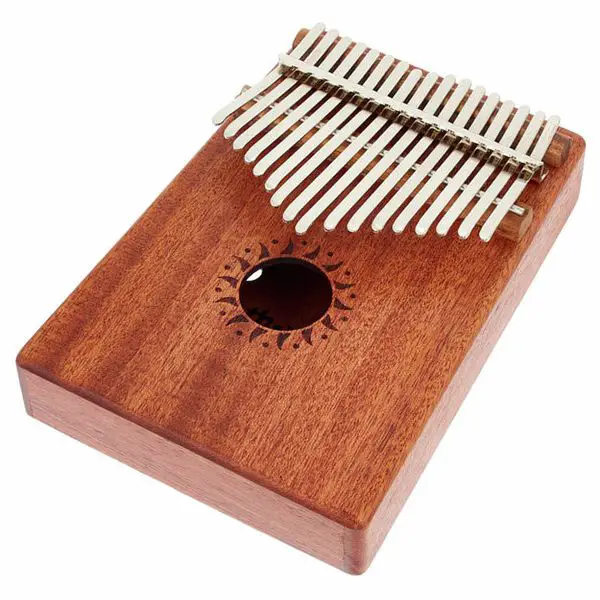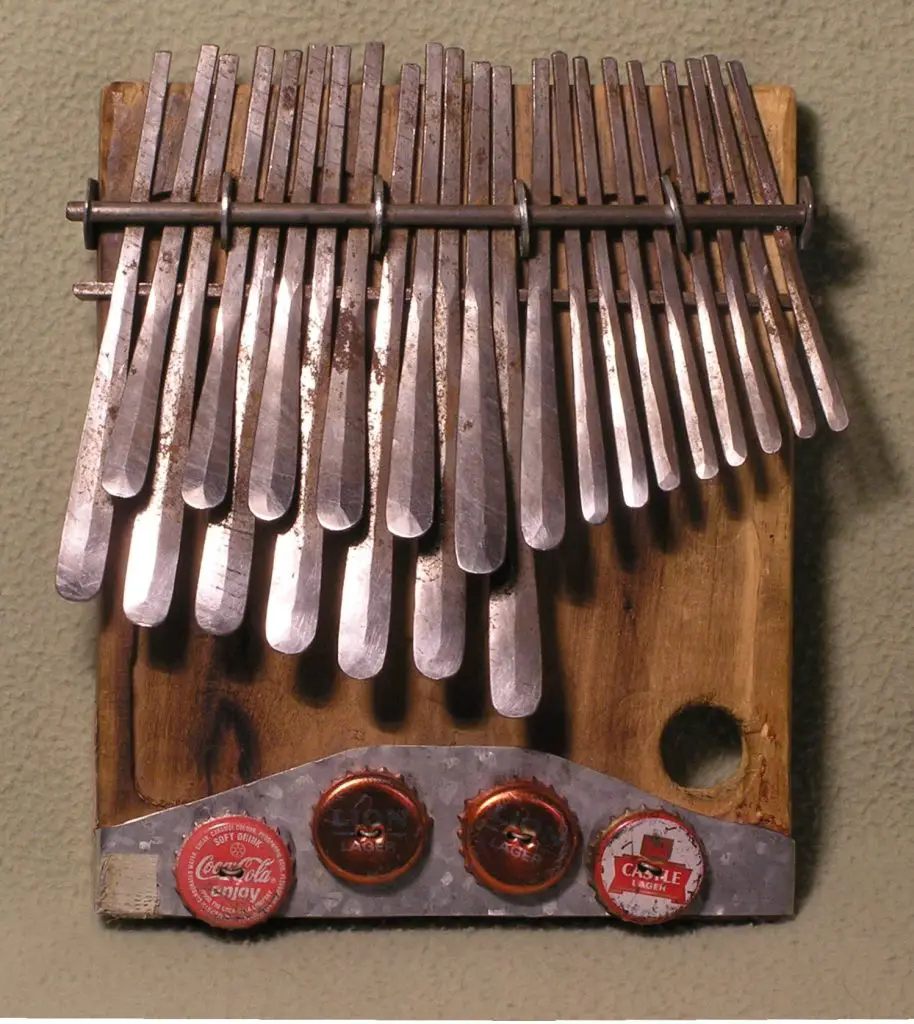Kalimba
Shona people from Zimbabwe have a long musical legacy that includes the use of a family of instruments known as mbira (or its modern version, the kalimba).
They are played by holding the instrument in the hands and plucking the tines with the thumbs (at a minimum), the right forefinger (most mbira), and sometimes the left forefinger. They consist of a wooden board (sometimes fitted with a resonator) with attached staggered metal tines.
The Kalimba or Mbira belongs to the plucked idiophone family of musical instruments and is referred to by musicologists as a lamellaphone. Many different types of mbira may be found in Eastern and Southern Africa. These instruments are frequently accompanied with hosho, a type of percussion instrument. It is a common sight to see this significant instrument being performed at weddings, funerals, and other types of social occasions. In the year 2020, the “Art of Crafting and Playing Mbira/Sansi, the Finger-Plucking Traditional Musical Instrument in Malawi and Zimbabwe” was added to the UNESCO Representative List of the Intangible Cultural Heritage of Humanity. This list is comprised of the world’s most important examples of intangible cultural heritage.
Hugh Tracey, an ethnomusicologist, commercially produced and sold a modern rendition of the instrument known as the kalimba in the late 1950s. This contributed to the popularity of instruments that were comparable to the kalimba outside of Africa.
The design that was created by Tracey was inspired by the mbira nyunga nyunga, and she gave it the name “Kalimba” in honor of an old member of the mbira family of instruments. The kalimba can be thought of as a westernized and simplified younger version of the mbira.
It was partly because to the success of singers like Earth, Wind and Fire’s Maurice White and Thomas Mapfumo that it gained popularity in the 1960s and early 1970s. In the 1970s, Mapfumo was particularly influential in this regard.
On stage, these performers played the mbira in addition to modern rock instruments including electric guitar and bass, drum kit, and horns. Their arrangements consisted of a great number of songs that were taken straight from the standard mbira repertoire. Ephat Mujuru, who was one of the pioneer teachers of mbira dzavadzimu in the United States, Dumisani Maraire, who brought marimba and karimba music to the American Pacific Northwest, and the writings and recordings of Zimbabwean musicians made by Paul Berliner are also important contributors to the development of mbira music outside of Africa. Since the 1970s, when she was a pupil of Dumisani Maraire, Claire Jones has been playing and teaching the mbira for more than four decades. In addition to that, she is the Festival Coordinator for Zimfest, which is a Zimbabwean Music Festival that takes place every year in North America and features a large number of performances, workshops, and other events centered around the mbira.
Both Joseph H. Howard and Babatunde Olatunji have made the argument that the mbira and other metal lamellaphones are inherently African and can only be discovered in regions that are inhabited by people of African descent or who are descended from Africans.
In the early 1900s, it was stated that people in the Okpuje and Nsukka areas of the south-eastern region of Nigeria utilized instruments that were quite similar to these.
Here are some more interesting points about the Kalimba.
- Global Popularity: Over the years, the kalimba has gained popularity not only in Africa but also globally. Its soothing and melodic tones have made it a favorite among musicians and enthusiasts from diverse cultural backgrounds. Its portability and relatively easy learning curve have contributed to its widespread appeal, leading to its incorporation into various music genres worldwide.
- Variety of Designs: While the basic design of the kalimba includes a wooden board with metal tines, there is a wide variety of designs available today. Kalimbas come in different shapes, sizes, and materials, allowing for variations in tone and aesthetics. Some modern kalimbas even feature amplification options for live performances and recording purposes.
- Innovation and Experimentation: Contemporary musicians and instrument makers continue to innovate and experiment with the kalimba, pushing its boundaries and exploring new possibilities. This includes the development of electric kalimbas, hybrid instruments combining the kalimba with other instruments or electronic effects, and the use of alternative materials for tines and resonators.
- Educational Tool: Beyond its musical applications, the kalimba serves as an educational tool in schools, music therapy sessions, and community workshops. Its simple design and intuitive playing technique make it accessible to people of all ages and musical backgrounds. Learning to play the kalimba promotes creativity, relaxation, and cultural appreciation.
- Cross-Cultural Collaboration: The kalimba has become a symbol of cross-cultural collaboration, bringing musicians from different backgrounds together to create unique and innovative music. Collaborations between African kalimba players and musicians from other regions have led to the fusion of diverse musical styles, resulting in captivating and boundary-pushing compositions.
- DIY Culture: With the rise of DIY culture and online communities, many enthusiasts are building their own kalimbas. DIY kalimba kits and tutorials are readily available, allowing individuals to customize their instruments according to their preferences. This DIY approach fosters creativity, experimentation, and a sense of ownership among kalimba players
- Social Media Influence: Social media platforms like YouTube and TikTok have played a significant role in popularizing the kalimba. Videos showcasing kalimba performances, tutorials, and covers of popular songs have garnered millions of views, inspiring a new generation of players and contributing to the instrument’s global visibility.
- Continued Evolution: The kalimba continues to evolve as artists and makers push the boundaries of traditional design and technique. Experimental kalimba tunings, extended range kalimbas, and innovative playing techniques are constantly being explored, expanding the sonic possibilities of the instrument and keeping it relevant in contemporary music scenes.
- Cultural Preservation: In addition to its role in contemporary music, the kalimba plays a vital role in preserving cultural heritage and traditions. Through performances, recordings, and educational programs, musicians and cultural organizations strive to ensure the continued relevance and appreciation of the kalimba within its cultural context.
- Therapeutic Benefits: The kalimba is often used in music therapy due to its soothing and calming tones. Playing the instrument can help reduce stress, anxiety, and promote relaxation and mindfulness. Its gentle sound vibrations have been found to have therapeutic effects on both the player and the listener, making it a valuable tool in mental health and wellness practices
Check out some of the easiest to play Kalimba tabs for popular songs such as Kiss The Rain, Streets of London, and You are my sunshine, and for kids, Incy wincy Spider. That’s of course, after you have tuned your instrument.
- Viola vs Violin – 5 Key Differences Between The Two Instruments - March 20, 2024
- 15 of the Most Famous Violinists of All Time (18th Century to Present) - March 20, 2024
- Full School Band Instruments List (Elementary / Middle / High) - March 18, 2024


